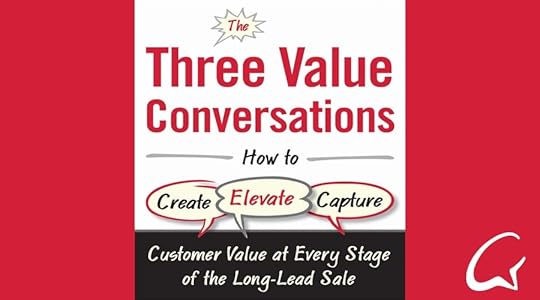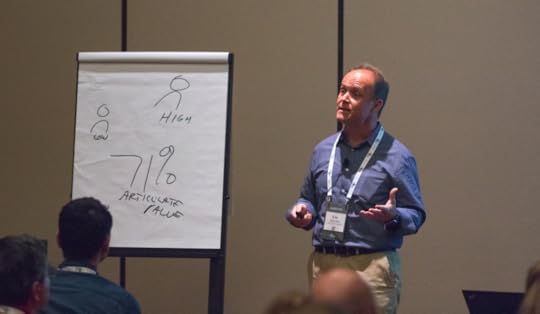Timothy Riesterer's Blog, page 19
September 21, 2016
Committing to Executive Conversations

Business impact through business outcomes—that’s the core of the new, executive-level messaging Cisco Systems wanted to take to the market. To make that message resonate with executive buyers, they knew it needed to elevate the conversation and make their sales interactions CXO relevant. And that’s how the Sales Masters program became engraved in Cisco Systems’ culture.
Each year, 2,400 salespeople go through the Sales Masters session, according to Rica Lieberman, director, sales acceleration at Cisco Systems. Engaging Corporate Visions’ to teach executive selling skills was a big part of making the Sales Masters program a training reality. Lieberman said Corporate Visions’ instructors understood Cisco culture and had a strong grasp of what was top of mind for them, particularly the company’s strategic initiatives.
Another factor that helped make Sales Masters a success: Continuity. Cisco took advantage of a standard set of Corporate Visions instructors, which helped build consistency and rigor into the company’s training initiatives.
#CTW16 Recap: Why Cisco Was Willing to Commit Three Days to Three Value Conversations Skills Training
Business impact through business outcomes—that’s the core of the new, executive-level messaging Cisco Systems wanted to take to the market. To make that message resonate with executive buyers, they knew it needed to elevate the conversation and make their sales interactions CXO relevant. And that’s how the Sales Masters program became engraved in Cisco Systems’ culture.
Each year, 2,400 salespeople go through the Sales Masters session, according to Rita Lieberman, director, sales acceleration at Cisco Systems. Engaging Corporate Visions’ to teach executive selling skills was a big part of making the Sales Masters program a training reality. Lieberman said Corporate Visions’ instructors understood Cisco culture and had a strong grasp of what was top of mind for them, particularly the company’s strategic initiatives.
Another factor that helped make Sales Masters a success: Continuity. Cisco took advantage of a standard set of Corporate Visions instructors, which helped build consistency and rigor into the company’s training initiatives.
Your Brain on Content

As marketers, you’re in the conversation with the customer throughout the buying cycle, as more buyers are relying on content to research their purchase options. That’s the good news that Leslie Talbot, Corporate Visions’ VP of Content, told her audience at Conversations That Win 2016. The bad news? Despite all this content consumption and engagement, 60 percent of qualified leads still end up in the “black hole of no decision.”
So here’s what we know:
51 percent of buyers rely more on content research buying options than they did in 2015.
83 percent are overwhelmed by the sheer volume of content.
50 percent of buyers say much of the content they receive is “mostly useless.”
According to Talbot, mere alignment between sales and marketing is not enough. The sales funnel was created for a low information world, and since we’re now in a high information world, that funnel has shattered because buyers now enter it at different stages. To contend with these challenges, you need to make a compelling case for your prospect to take an action or make a change. You need to shake them loose from their status quo. Understanding how humans frame value and make decisions is critical to telling that status quo-busting story. And if you do it well, you can, as Talbot said, “crack the code on how to get prospects to change their behavior.”
One memorable way to think about great storytelling in the high-information age is a concept called the “three Cs”—context, contrast and concrete—which are summarized below:
Context – Frame your story within the context of the buyer’s experience, and aim to disrupt that experience by delivering insights that will make them think differently about their world and how they’re approaching it today. The more disruptive your insight, the better story you’ll tell.
Contrast – Value lies in contrast, not in touting the capabilities and differentiators of your solution. A great way to unhinge the status quo is to paint a picture of contrast between the pain of your prospect’s current situation and the upside of a new and better future state, which you can lead them to.
Concrete – The “old brain” or “lizard brain”—the emotional core of our brains that controls decision-making—responds to simple concrete visuals. You can take advantage of this factor by using simple imagery that makes change seem actionable, digestible and less daunting.
#CTW16 Recap: Your Brain on Content
As marketers, you’re in the conversation with the customer throughout the buying cycle, as more buyers are relying on content to research their purchase options. That’s the good news that Leslie Talbot, Corporate Visions’ VP of Content, told her audience at Conversations That Win 2016. The bad news? Despite all this content consumption and engagement, 60 percent of qualified leads still end up in the “black hole of no decision.”
So here’s what we know:
51 percent of buyers rely more on content research buying options than they did in 2015.
83 percent are overwhelmed by the sheer volume of content.
50 percent of buyers say much of the content they receive is “mostly useless.”
According to Talbot, mere alignment between sales and marketing is not enough. The sales funnel was created for a low information world, and since we’re now in a high information world, that funnel has shattered because buyers now enter it at different stages. To content with these challenges, you need to make a compelling case for your prospect to take an action or make a change. You need to shake them loose from their status quo. Understanding how humans frame value and make decisions is critical to telling that status quo-busting story. And if you do it well, you can, as Talbot said, “crack the code on how to get prospects to change their behavior.”
One memorable way to think about great storytelling in the high-information age is a concept called the “three Cs”—context, contrast and concrete—which are summarized below:
Context – Frame your story within the context of the buyer’s experience, and aim to disrupt that experience by delivering insights that will make them think differently about their world and how they’re approaching it today. The more disruptive your insight, the better story you’ll tell.
Contrast – Value lies in contrast, not in touting the capabilities and differentiators of your solution. A great way to unhinge the status quo is to paint a picture of contrast between the pain of your prospect’s current situation and the upside of a new and better future state, which you can lead them to.
Concrete – The “old brain” or “lizard brain”—the emotional core of our brains that controls decision-making—responds to simple concrete visuals. You can take advantage of this factor by using simple imagery that makes change seem actionable, digestible and less daunting.
Closing the Conversion Gap

How do you give your team the ability to create differentiated stories for every customer business problem you solve? Without the skills and the methodology to guide that process, your messages may lack consistency and impact, and—worse—your prospects and customers could end up hearing a different story every time they interact with you.
Not too long ago, Intelsat, a communications satellite services provider, was struggling to implement a marketing methodology they had invested in, and turned to Corporate Visions to try a different approach. Lynette Simmons, a marketing leader at Intelsat, said they experienced a Power Positioning workshop with Corporate Visions, which also included writer certification and wireframe templates.
Today, the company leverages a Conversation Roadmap—a primary deliverable from the Power Positioning engagement—which Intelsat created themselves and refined with a Corporate Visions consultant. The regional team used that roadmap to create multiple assets that were region-specific, while integrated marketing created a range of thought leadership assets.
Below are Simmons’ tips for getting the most out of your Power Positioning messaging engagement:
Top-down commitment is critical. Have everyone in the organization work from the same corporate strategy map to foster great alignment.
Empower “champions” in your teams. Make them project managers during product launches.
Your full content library cannot change overnight. Commit to a “from this day forward” mentality and refresh when opportunities arise.
Build leaders in your team to enforce the methodology.
Familiarize your creative team with conversation roadmaps and methodology.
Shortcuts can work—partner with a great company instead of trying to implement a messaging methodology on your own.
Scaling The Power Positioning Methodology
Kathy Meyer (senior director, sales enablement and tools, information management, Kodak Alaris) experienced a Power Positioning workshop with Corporate Visions in May 2014. For the event, Kodak Alaris brought in four sales VPs and their top selling reps to help craft the message. Within three weeks of the workshop, all messaging assets were delivered. And by October 2014:
47 percent said Power Positioning was the best training they’ve experienced.
53 percent said it was better than most.
100 percent said it would impact their job.
100 percent said they wanted “more training like this.”
What’s more, the company added $1 million in pipeline in the first 90 days after implementation.
To scale the methodology, Kodak trained 14 marketers and taught them how to do the power positioning methodology training. They started simple, using a few internal documents, then went big in 2016, hiring an agency to create all assets.
#CTW16 Recap: Closing the Conversion Gap
How do you give your team the ability to create differentiated stories for every customer business problem you solve? Without the skills and the methodology to guide that process, your messages may lack consistency and impact, and—worse—your prospects and customers could end up hearing a different story every time they interact with you.
Not too long ago, Intelsat, a communications satellite services provider, was struggling to implement a marketing methodology they had invested in, and turned to Corporate Visions to try a different approach. Lynette Simmons, a marketing leader at Intelsat, said they experienced a Power Positioning workshop with Corporate Visions, which also included writer certification and wireframe templates.
Today, the company leverages a Conversation Roadmap—a primary deliverable from the Power Positioning engagement—which Intelsat created themselves and refined with a Corporate Visions consultant. The regional team used that roadmap to create multiple assets that were region-specific, while integrated marketing created a range of thought leadership assets.
Below are Simmons’ tips for getting the most out of your Power Positioning messaging engagement:
Top-down commitment is critical. Have everyone in the organization work from the same corporate strategy map to foster great alignment.
Empower “champions” in your teams. Make them project managers during product launches.
Your full content library cannot change overnight. Commit to a “from this day forward” mentality and refresh when opportunities arise.
Build leaders in your team to enforce the methodology.
Familiarize your creative team with conversation roadmaps and methodology.
Shortcuts can work—partner with a great company instead of trying to implement a messaging methodology on your own.
Scaling The Power Positioning Methodology
Kathy Meyer (senior director, sales enablement and tools, information management, Kodak Alaris) experienced a Power Positioning workshop with Corporate Visions in May 2014. For the event, Kodak Alaris brought in four sales VPs and their top selling reps to help craft the message. Within three weeks of the workshop, all messaging assets were delivered. And by October 2014:
47 percent said Power Positioning was the best training they’ve experienced.
53 percent said it was better than most.
100 percent said it would impact their job.
100 percent said they wanted “more training like this.”
What’s more, the company added $1 million in pipeline in the first 90 days after implementation.
To scale the methodology, Kodak trained 14 marketers and taught them how to do the power positioning methodology training. They started simple, using a few internal documents, then went big in 2016, hiring an agency to create all assets.
Enabling the Three Value Conversations

In his keynote at #CTW16, Corporate Visions’ Tim Riesterer positioned the “triple threat” as a sales ideal, likening the rep who masters the entire buying cycle to Gene Kelly, one of Hollywood’s original triple threats, who excelled at acting, dancing and singing.
But the concept of the sales triple threat is relevant to product marketers and sales enablement leaders too, especially if you’re trying to unify your marketing and sales message and develop content that reinforces winning behaviors. And so there was no escaping a Gene Kelly reference in the marketing breakout session on Enabling the Three Value Conversations, led by Eric Nitschke, director of product marketing and sales enablement at Corporate Visions.
To make articulating value a mainstay of your content (and by extension, your sales team), Nitschke advised that companies focus their messaging efforts on three moments of truth in every buying cycle—or three “value conversations.”
Value Conversation #1: Create Value – This is where your message needs to defeat the status quo bias and create clear differentiation between you and your competition. Your “why change” story should follow a specific choreography that you can incorporate in your content, leading prospects from an insight, to an explanation of how their current approach is flawed, to a new and safer approach, and—finally—to a better outcome. This story needs to be disruptive, and it has to create urgency by demonstrating what the consequences of buyer inaction will be.
Value Conversation #2: Elevate Value – This is where enablement content has to help salespeople create a business case that passes muster with savvy executive-level buyers. You can create an executive buying vision by first adopting a CXO-relevant perspective, and linking their external factors and business initiatives to a business change scenario that yields performance improvements and measurable results.
Value Conversation #3: Capture Value – Develop content that prepares reps to negotiate better and more creatively. One way to do this most effectively is by leading with an unconsidered need, which can expand the value of (and need for) your solutions, and give your reps leverage as pricing tension heats up.
#CTW16 Recap: Enabling the Three Value Conversations
In his keynote at #CTW16, Corporate Visions’ Tim Riesterer positioned the “triple threat” as a sales ideal, likening the rep who masters the entire buying cycle to Gene Kelly, one of Hollywood’s original triple threats, who excelled at acting, dancing and singing.
But the concept of the sales triple threat is relevant to product marketers and sales enablement leaders too, especially if you’re trying to unify your marketing and sales message and develop content that reinforces winning behaviors. And so there was no escaping a Gene Kelly reference in the marketing breakout session on Enabling the Three Value Conversations, led by Eric Nitschke, director of product marketing and sales enablement at Corporate Visions.

Corporate Visions’ Eric Nitschke talks marketing and sales message unification at #CTW16.
To make articulating value a mainstay of your content (and by extension, your sales team), Nitschke advised that companies focus their messaging efforts on three moments of truth in every buying cycle—or three “value conversations.”
Value Conversation #1: Create Value – This is where your message needs to defeat the status quo bias and create clear differentiation between you and your competition. Your “why change” story should follow a specific choreography that you can incorporate in your content, leading prospects from an insight, to an explanation of how their current approach is flawed, to a new and safer approach, and—finally—to a better outcome. This story needs to be disruptive, and it has to create urgency by demonstrating what the consequences of buyer inaction will be.
Value Conversation #2: Elevate Value – This is where enablement content has to help salespeople create a business case that passes muster with savvy executive-level buyers. You can create an executive buying vision by first adopting a CXO-relevant perspective, and linking their external factors and business initiatives to a business change scenario that yields performance improvements and measurable results.
Value Conversation #3: Capture Value – Develop content that prepares reps to negotiate better and more creatively. One way to do this most effectively is by leading with an unconsidered need, which can expand the value of (and need for) your solutions, and give your reps leverage as pricing tension heats up.
It’s Da “BOM”! How a “bill of materials” makes sales enablement content more readily available to reps

For as long as there has been product marketing, there have been launch kits, from glossy brochures and multi-page spec sheets to the infamous tech-heavy “product deck.” These assets help your reps talk fluently about your products…but not much else. That’s why Wipro’s Thierry van Herwijnen believes the standard launch checklist needs a rethink, and companies need to start investing in knowledge management—which is part of the overall sales enablement organization at Wipro.
One reason necessitating the investment in better management of sales enablement assets? Deals are already complex, and they’re getting more so. Van Herwijnen noted there are 11 different touch points for reps before a decision is made, and their sales cycles last between six months and two years. What’s more, 6.4 stakeholders are involved in their buying decisions.
To face these realities, he said Wipro had to develop a vision around knowledge management—one that would ultimately equip sales teams with the range of messages, insights and tools they need to have winning sales conversations.
By moving toward a more predictable model for their “bill of materials” (a.k.a. “BOM”), Wipro has made their enablement content more readily available to reps right from their sales portal. This has helped the company overcome some major sales enablement challenges, such as lack of consistency in content, limited accountability and measurement, and limited governance.
By making the jump from knowledge to wisdom with knowledge management, van Herwijnen says Wipro has made strides in the following areas of their sales enablement program:
Sales content optimization and governance
Adoption and messaging supply chain optimization
Sales insights delivery
Alignment between sales and marketing
Social selling participation and buy-in
Corporate Visions was instrumental in improving this process, according to van Herwijnen. Corporate Visions worked with Wipro and conducted a sample audit looking at all current assets, recommended improvements, and established a baseline message to help reinforce message consistency. Wipro also took advantage of Corporate Visions templates to help them seamlessly incorporate messaging from its Conversation Roadmap into its sales enablement assets.
#CTW16 Recap: It’s Da “BOM”
For as long as there has been product marketing, there have been launch kits, from glossy brochures and multi-page spec sheets to the infamous tech-heavy “product deck.” These assets help your reps talk fluently about your products…but not much else. That’s why Wipro’s Thierry van Herwijnen believes the standard launch checklist needs a rethink, and companies need to start investing in knowledge management—which is part of the overall sales enablement organization at Wipro.
One reason necessitating the investment in better management of sales enablement assets? Deals are already complex, and they’re getting more so. Van Herwijnen noted there are 11 different touch points for reps before a decision is made, and their sales cycles last between six months and two years. What’s more, 6.4 stakeholders are involved in their buying decisions.
To face these realities, he said Wipro had to develop a vision around knowledge management—one that would ultimately equip sales teams with the range of messages, insights and tools they need to have winning sales conversations.
By moving toward a more predictable model for their “bill of materials” (a.k.a. “BOM”), Wipro has made their enablement content more readily available to reps right from their sales portal. This has helped the company overcome some major sales enablement challenges, such as lack of consistency in content, limited accountability and measurement, and limited governance.
By making the jump from knowledge to wisdom with knowledge management, van Herwijnen says Wipro has made strides in the following areas of their sales enablement program:
Sales content optimization and governance
Adoption and messaging supply chain optimization
Sales insights delivery
Alignment between sales and marketing
Social selling participation and buy-in
Corporate Visions was instrumental in improving this process, according to van Herwijnen. Corporate Visions worked with Wipro and conducted a sample audit looking at all current assets, recommended improvements, and established a baseline message to help reinforce message consistency. Wipro also took advantage of Corporate Visions templates to help them seamlessly incorporate messaging from its Conversation Roadmap into its sales enablement assets.
Timothy Riesterer's Blog
- Timothy Riesterer's profile
- 3 followers



